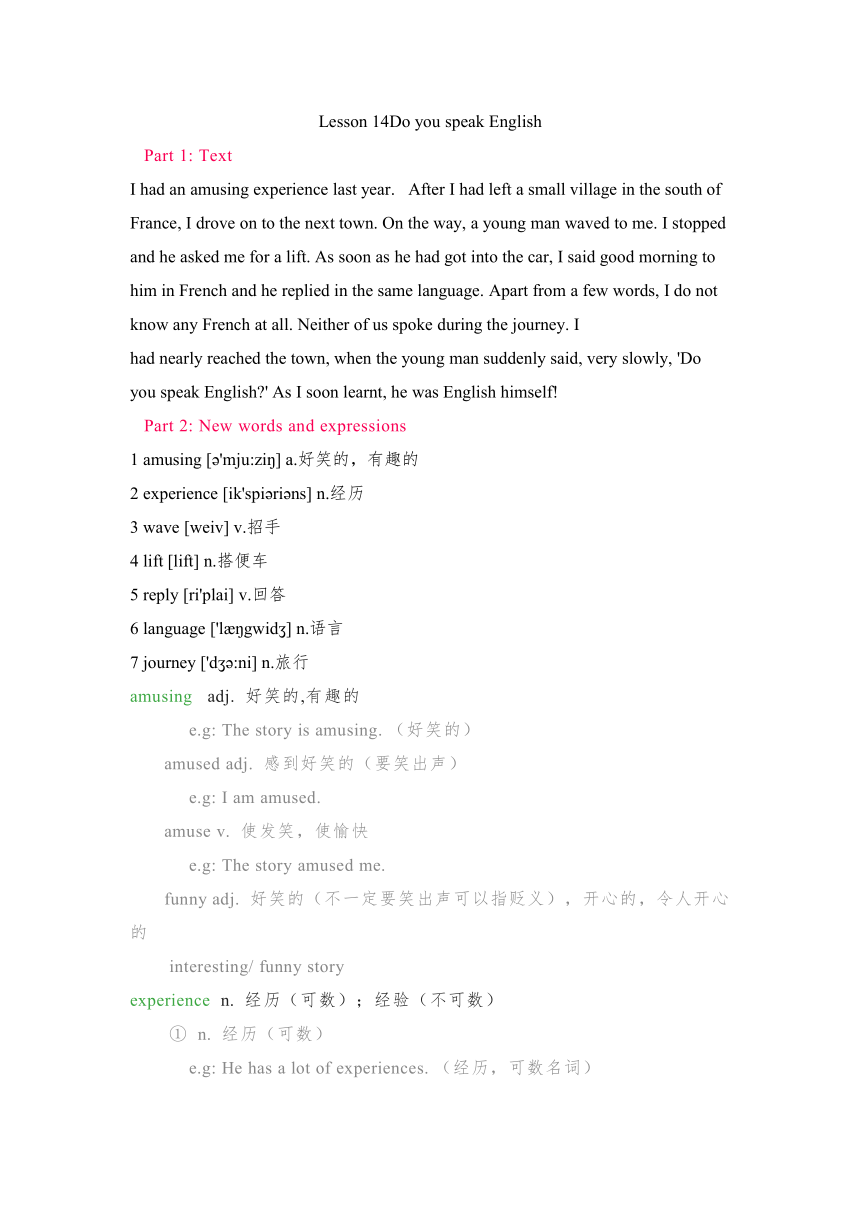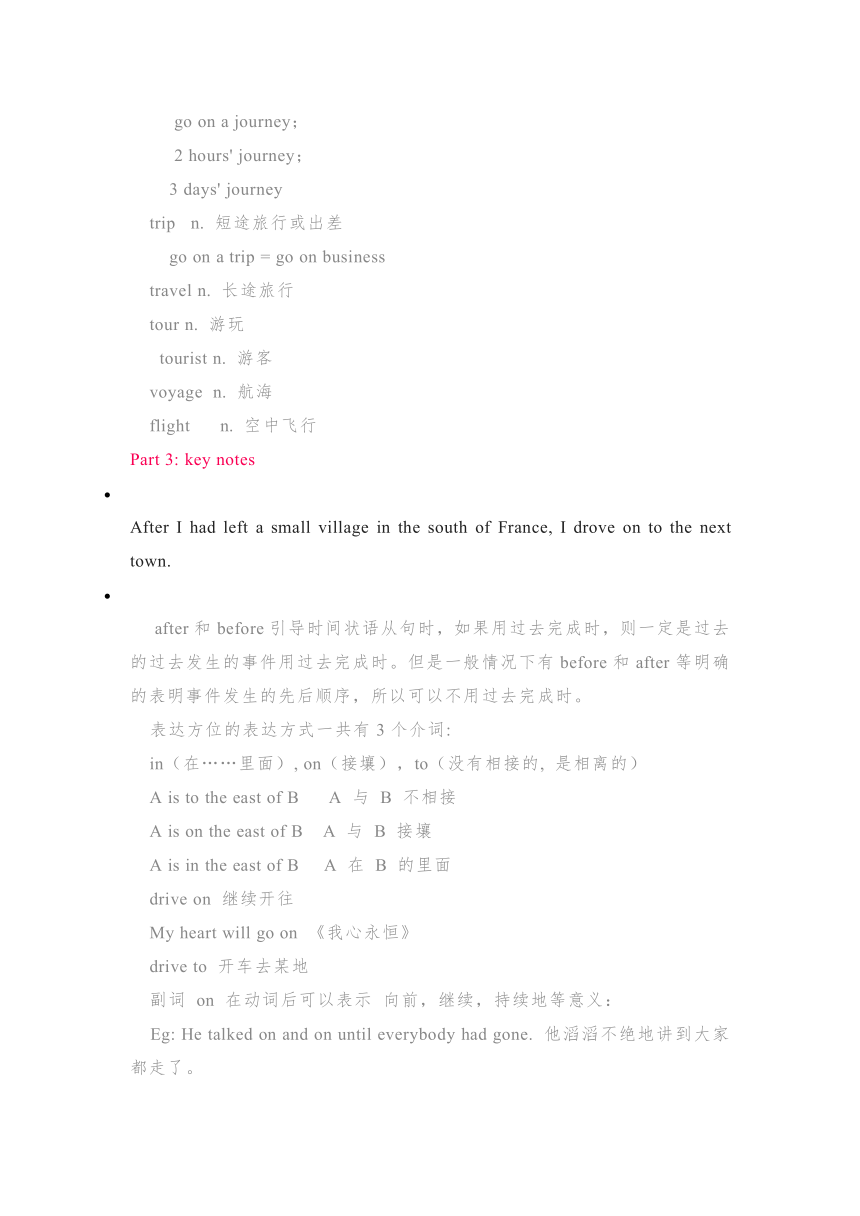新概念英语第二册 Lesson 14 Do you speak English 讲义
文档属性
| 名称 | 新概念英语第二册 Lesson 14 Do you speak English 讲义 |  | |
| 格式 | docx | ||
| 文件大小 | 23.6KB | ||
| 资源类型 | 教案 | ||
| 版本资源 | 新概念英语 | ||
| 科目 | 英语 | ||
| 更新时间 | 2023-09-26 16:59:12 | ||
图片预览



文档简介
Lesson 14Do you speak English
Part 1: Text
I had an amusing experience last year. After I had left a small village in the south of France, I drove on to the next town. On the way, a young man waved to me. I stopped and he asked me for a lift. As soon as he had got into the car, I said good morning to him in French and he replied in the same language. Apart from a few words, I do not know any French at all. Neither of us spoke during the journey. I
had nearly reached the town, when the young man suddenly said, very slowly, 'Do you speak English ' As I soon learnt, he was English himself!
Part 2: New words and expressions
1 amusing [ 'mju:zi ] a.好笑的,有趣的
2 experience [ik'spi ri ns] n.经历
3 wave [weiv] v.招手
4 lift [lift] n.搭便车
5 reply [ri'plai] v.回答
6 language ['l gwid ] n.语言
7 journey ['d :ni] n.旅行
amusing adj. 好笑的,有趣的
e.g: The story is amusing. (好笑的)
amused adj. 感到好笑的(要笑出声)
e.g: I am amused.
amuse v. 使发笑,使愉快
e.g: The story amused me.
funny adj. 好笑的(不一定要笑出声可以指贬义),开心的,令人开心的
interesting/ funny story
experience n. 经历(可数);经验(不可数)
① n. 经历(可数)
e.g: He has a lot of experiences. (经历,可数名词)
② n. 经验,体验(不可数)
e.g: They want someone with a lot of experience for this job. (经验,不可数名词)
e.g: Does she have any experience in teaching
③ vt. 经验,体验
e.g: Have you ever experienced anything like this
e.g: The village has experienced great changes since 1980.
experienced adj. 有经验的,经验丰富的
e.g: He is an experienced doctor.
wave v. 招手
wave to sb. 向某人招手
wave one's hand 挥手
wave n. 波浪
lift n. 搭便车
take a bus/taxi/lift 乘公共汽车/乘出租汽车/搭便车
Sb. wants to take a lift. 某人想搭个便车
A give B a lift. 让某人搭便车
e.g: The student gave me a lift.
thumb lift 拇指便车
reply v. 回答
reply与 answer 的区别:
answer常用词,指用书面、口头或行动对他人的请求、询问、质问等作出回答 或反应
reply较正式用词,较少用于口语。侧重经过考虑的较正式答复。
language n. 语言
native language 母语
mother tongue 母语(口语)
journey n. 旅行
journey n. 所有的旅行,偏重于陆地
go on a journey;
2 hours' journey;
3 days' journey
trip n. 短途旅行或出差
go on a trip = go on business
travel n. 长途旅行
tour n. 游玩
tourist n. 游客
voyage n. 航海
flight n. 空中飞行
Part 3: key notes
After I had left a small village in the south of France, I drove on to the next town.
after和before引导时间状语从句时,如果用过去完成时,则一定是过去的过去发生的事件用过去完成时。但是一般情况下有before和after等明确的表明事件发生的先后顺序,所以可以不用过去完成时。
表达方位的表达方式一共有3 个介词:
in(在……里面), on(接壤),to(没有相接的, 是相离的)
A is to the east of B A 与 B 不相接
A is on the east of B A 与 B 接壤
A is in the east of B A 在 B 的里面
drive on 继续开往
My heart will go on 《我心永恒》
drive to 开车去某地
副词 on 在动词后可以表示 向前,继续,持续地等意义:
Eg: He talked on and on until everybody had gone. 他滔滔不绝地讲到大家都走了。
Eg: I was reading when my friend called. After he had gone, I went on to read.
我朋友来看我时我正在看书。他走了以后我便继续看书。
On the way, a young man waved to me.
on the way 在路上,在途中
on one's way to someplace 在某人去某地的途中
I met an old friend on my way to school.
wave to sb. 冲某人挥手
As soon as he had got into the car, I said good morning to him in French and he replied in the same language.
as soon as 一……就……,后加时间状语从句, 强调两个动作几乎是连在一起的,但仍然有先后顺序。
Eg: As soon as I had entered the room, I took off my coat at once.
强调:只要是状语从句,不管是时间状语从句还是原因状语从句还是条件状语从句,从句中不能有将来时, 一律用一般现在时表将来
Eg: As soon as you arrive, I'll be there waiting for you.
You will find this movie fantastic if you see it.
表示用某种语言作为交际手段时介词用 in,表示讲某种语言时不加介词。
Eg: I speak English. I say a word in Chinese.
reply要想加宾语要加 to (+要回答的对象),而 in the same language 在句中作状语, 不是 reply所应回答的问题(宾语), 故用 in
Apart from a few words, I do not know any French at all.
apart from…除……以外
not… at all 否定的强调
Eg: I don't like it at all.
英语中有时会用双重否定表示否定的强调:
Eg: I didn't do nothing at all! 我什么也没做!!!
I had nearly reached the town, when the young man suddenly said, very slowly, "Do you speak English "
nearly 几乎,快要
when在这里译为“就在此时”
Eg: I had nearly reached home when I found my mother standing there.
Do you speak English
你说英语吗 你是说英语国家的人吗
注意和Can you speak English 区分。
As I soon learnt, he was English himself!'
I learn 我得知(强调过程);I know 我知道(我本来就知道)
As从句(As my mother said/As I heard/ As I learnt)正如……
Eg: As we know, the New Concept English is very good.
Eg: As he said, English is easy to learn.
Part 4: Grammar
After I had left a small village in the south of France, I drove on to the next town.
过去完成时 “Had + done”
过去的过去或两个动作都在过去,一个动作在前,一个在后,发生在前的动作为过去完成时。
过去完成时一定要以一个过去时态做铺垫,这个动作一定要发生在had done之后。常用:
when, after, before, not …until , By the time 等词连接两个句子。
The children ran away. They broke the window.
The children ran away after they had broken the window.
The sun set. We returned to our hotel.
As soon as the sun had set we returned to our hotel.
He finished lunch. He asked for a glass of water.
When he had finished lunch he asked for a glass of water.
I did not understand the problem. He explained it.
I had not understood the problem until he explained it.
Part 5: Homework
1.背诵lesson 14单词&课文
2.Retell the story
3.完成Lesson 14配套练习
Part 1: Text
I had an amusing experience last year. After I had left a small village in the south of France, I drove on to the next town. On the way, a young man waved to me. I stopped and he asked me for a lift. As soon as he had got into the car, I said good morning to him in French and he replied in the same language. Apart from a few words, I do not know any French at all. Neither of us spoke during the journey. I
had nearly reached the town, when the young man suddenly said, very slowly, 'Do you speak English ' As I soon learnt, he was English himself!
Part 2: New words and expressions
1 amusing [ 'mju:zi ] a.好笑的,有趣的
2 experience [ik'spi ri ns] n.经历
3 wave [weiv] v.招手
4 lift [lift] n.搭便车
5 reply [ri'plai] v.回答
6 language ['l gwid ] n.语言
7 journey ['d :ni] n.旅行
amusing adj. 好笑的,有趣的
e.g: The story is amusing. (好笑的)
amused adj. 感到好笑的(要笑出声)
e.g: I am amused.
amuse v. 使发笑,使愉快
e.g: The story amused me.
funny adj. 好笑的(不一定要笑出声可以指贬义),开心的,令人开心的
interesting/ funny story
experience n. 经历(可数);经验(不可数)
① n. 经历(可数)
e.g: He has a lot of experiences. (经历,可数名词)
② n. 经验,体验(不可数)
e.g: They want someone with a lot of experience for this job. (经验,不可数名词)
e.g: Does she have any experience in teaching
③ vt. 经验,体验
e.g: Have you ever experienced anything like this
e.g: The village has experienced great changes since 1980.
experienced adj. 有经验的,经验丰富的
e.g: He is an experienced doctor.
wave v. 招手
wave to sb. 向某人招手
wave one's hand 挥手
wave n. 波浪
lift n. 搭便车
take a bus/taxi/lift 乘公共汽车/乘出租汽车/搭便车
Sb. wants to take a lift. 某人想搭个便车
A give B a lift. 让某人搭便车
e.g: The student gave me a lift.
thumb lift 拇指便车
reply v. 回答
reply与 answer 的区别:
answer常用词,指用书面、口头或行动对他人的请求、询问、质问等作出回答 或反应
reply较正式用词,较少用于口语。侧重经过考虑的较正式答复。
language n. 语言
native language 母语
mother tongue 母语(口语)
journey n. 旅行
journey n. 所有的旅行,偏重于陆地
go on a journey;
2 hours' journey;
3 days' journey
trip n. 短途旅行或出差
go on a trip = go on business
travel n. 长途旅行
tour n. 游玩
tourist n. 游客
voyage n. 航海
flight n. 空中飞行
Part 3: key notes
After I had left a small village in the south of France, I drove on to the next town.
after和before引导时间状语从句时,如果用过去完成时,则一定是过去的过去发生的事件用过去完成时。但是一般情况下有before和after等明确的表明事件发生的先后顺序,所以可以不用过去完成时。
表达方位的表达方式一共有3 个介词:
in(在……里面), on(接壤),to(没有相接的, 是相离的)
A is to the east of B A 与 B 不相接
A is on the east of B A 与 B 接壤
A is in the east of B A 在 B 的里面
drive on 继续开往
My heart will go on 《我心永恒》
drive to 开车去某地
副词 on 在动词后可以表示 向前,继续,持续地等意义:
Eg: He talked on and on until everybody had gone. 他滔滔不绝地讲到大家都走了。
Eg: I was reading when my friend called. After he had gone, I went on to read.
我朋友来看我时我正在看书。他走了以后我便继续看书。
On the way, a young man waved to me.
on the way 在路上,在途中
on one's way to someplace 在某人去某地的途中
I met an old friend on my way to school.
wave to sb. 冲某人挥手
As soon as he had got into the car, I said good morning to him in French and he replied in the same language.
as soon as 一……就……,后加时间状语从句, 强调两个动作几乎是连在一起的,但仍然有先后顺序。
Eg: As soon as I had entered the room, I took off my coat at once.
强调:只要是状语从句,不管是时间状语从句还是原因状语从句还是条件状语从句,从句中不能有将来时, 一律用一般现在时表将来
Eg: As soon as you arrive, I'll be there waiting for you.
You will find this movie fantastic if you see it.
表示用某种语言作为交际手段时介词用 in,表示讲某种语言时不加介词。
Eg: I speak English. I say a word in Chinese.
reply要想加宾语要加 to (+要回答的对象),而 in the same language 在句中作状语, 不是 reply所应回答的问题(宾语), 故用 in
Apart from a few words, I do not know any French at all.
apart from…除……以外
not… at all 否定的强调
Eg: I don't like it at all.
英语中有时会用双重否定表示否定的强调:
Eg: I didn't do nothing at all! 我什么也没做!!!
I had nearly reached the town, when the young man suddenly said, very slowly, "Do you speak English "
nearly 几乎,快要
when在这里译为“就在此时”
Eg: I had nearly reached home when I found my mother standing there.
Do you speak English
你说英语吗 你是说英语国家的人吗
注意和Can you speak English 区分。
As I soon learnt, he was English himself!'
I learn 我得知(强调过程);I know 我知道(我本来就知道)
As从句(As my mother said/As I heard/ As I learnt)正如……
Eg: As we know, the New Concept English is very good.
Eg: As he said, English is easy to learn.
Part 4: Grammar
After I had left a small village in the south of France, I drove on to the next town.
过去完成时 “Had + done”
过去的过去或两个动作都在过去,一个动作在前,一个在后,发生在前的动作为过去完成时。
过去完成时一定要以一个过去时态做铺垫,这个动作一定要发生在had done之后。常用:
when, after, before, not …until , By the time 等词连接两个句子。
The children ran away. They broke the window.
The children ran away after they had broken the window.
The sun set. We returned to our hotel.
As soon as the sun had set we returned to our hotel.
He finished lunch. He asked for a glass of water.
When he had finished lunch he asked for a glass of water.
I did not understand the problem. He explained it.
I had not understood the problem until he explained it.
Part 5: Homework
1.背诵lesson 14单词&课文
2.Retell the story
3.完成Lesson 14配套练习
同课章节目录
